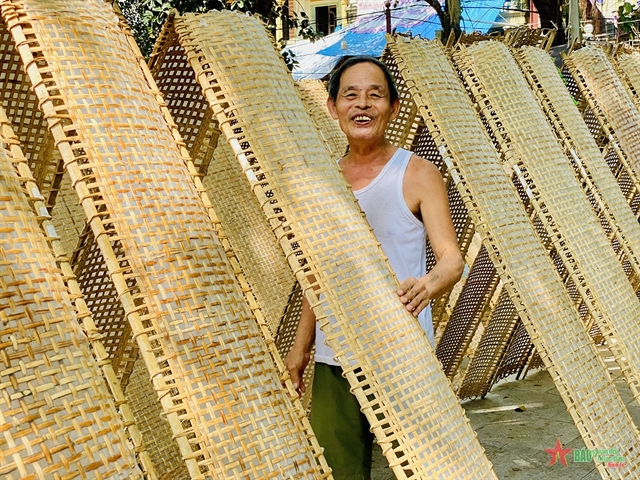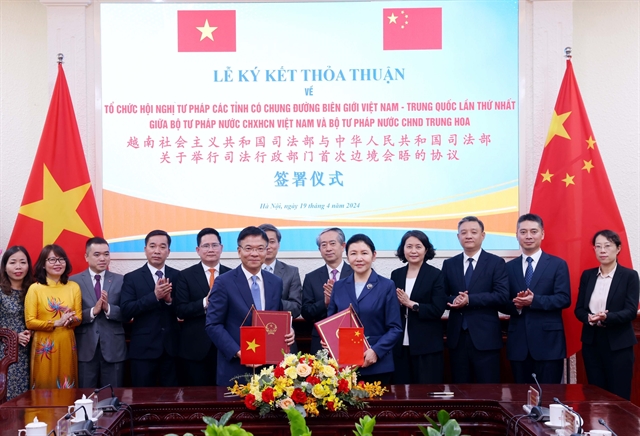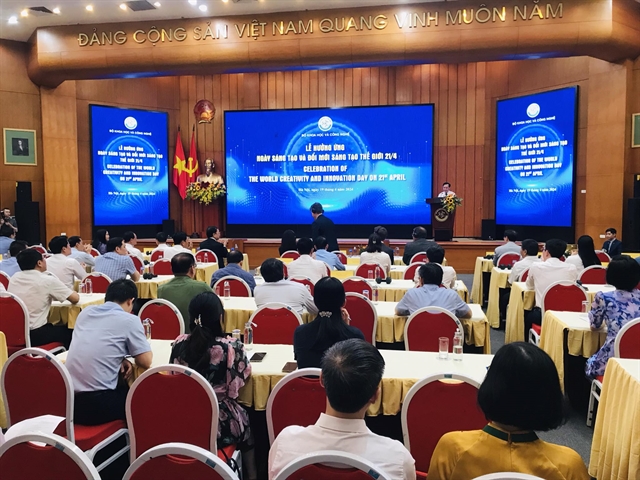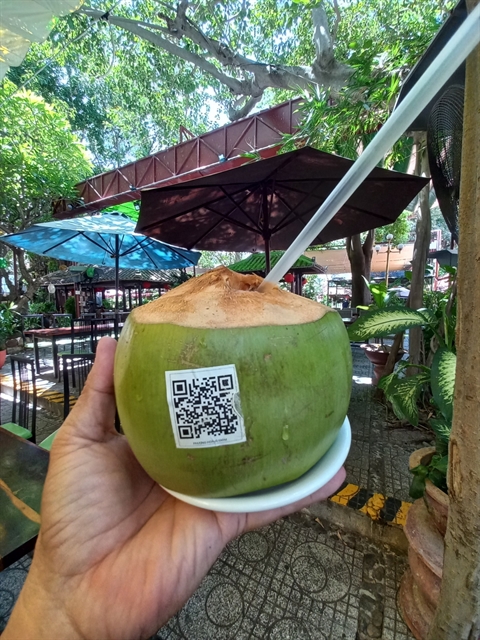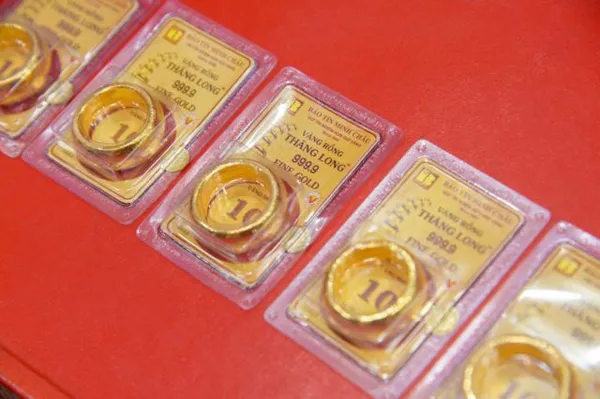

Traditional long dresses for men are slowly coming back into fashion.
This is thanks to a men’s group whose members wear them and hope that other men will do so too.
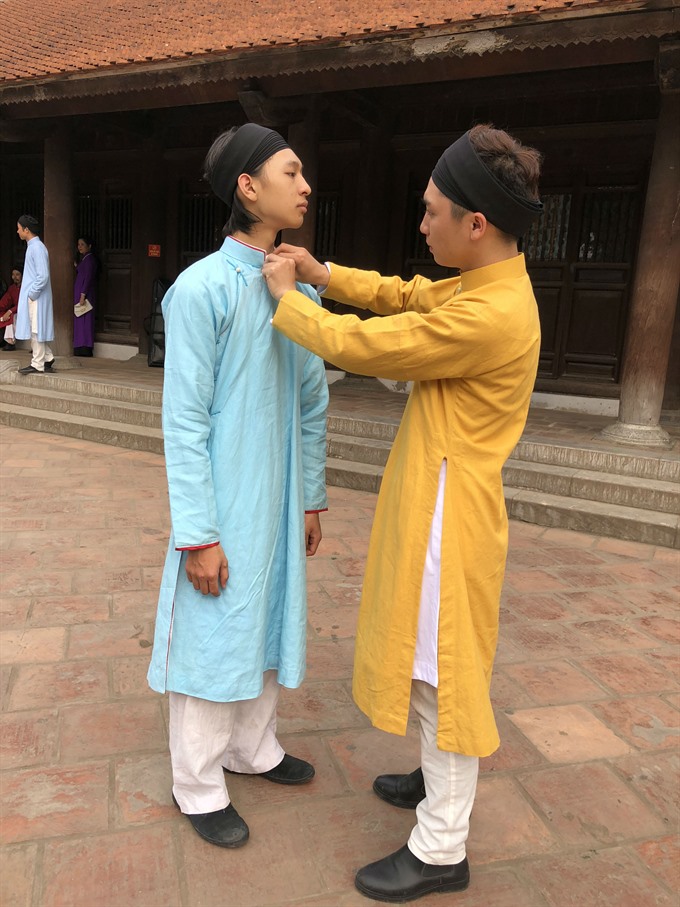 |
| Traditional teamwork: Chu Đức Giang helps his friend Phạm Quý Du wear a traditional long dress. VNS Photo Lê Hương |
Traditional long dresses for men are slowly coming back into fashion.
This is thanks to a men’s group whose members wear them and hope that other men will do so too.
During colonial times, men started to wear Western suits more often.
When Vietnamese men wear traditional long dresses while on overseas visits, they can attract a lot of attention because they look quite different to other types of clothes.
By Lê Hương & Hồng Vân
Carefully wrapping a black turban on his friend’s head, Chu Đức Giang is helping his friend take a trip back in time.
With the sun shining as bright as the clothes Giang and his friend wear, these two young men are keeping a tradition alive through the robes on their backs.
They spent a Sunday morning joining other members of the Traditional Long Dress for Men’s Club to tour the Literature Temple and the Imperial Academy, the first university of Việt Nam built in 11th century in downtown Hà Nội.
The men’s group wear áo dài (traditional long dress) and during their tour, pause from time to time to lend a listening ear to the guide.
Although they may look like they have arrived from days gone by, their ancient appearance is given a modern twist as many reach for their cell phones to take a selfie or two.
The newly established club, a smaller group of Đình Làng Việt (Vietnamese Communal Houses), which is keen on preserving the ancient values of communal houses, sometimes organises such an event to encourage members to wear áo dài.
As well as drawing many a curious glance from foreign tourists, they hope their clothing with see other men follow suit.
“As a member of Đình Làng Việt group, I joined most of its activities including Tết Việt (Vietnamese traditional Lunar New Year) event at So Village on the outskirts of Hà Nội. At the first event three years ago, I rented an áo dài. Then I got one tailored. Recently, another club member Hoàng Dương and I designed a collection of áo dài titled ‘Now and Then’ of items with traditional features adequately changed to suit modern times,” Giang told Việt Nam News.
As a young man who loves traditional culture, Giang feels proud whenever he wears áo dài.
“I think áo dài is not only beautiful in aesthetic but also in moral standards. When wearing it, I feel more mature and tend to be more careful in my behaviour. The costume makes me Mr Right in the traditional standard. It is a heritage,” he said.
Giang added that some details from the traditional design were changed to suit today’s youth such as smaller sleeves, smaller hems for pants and various modern materials such as linen, tweed and even jeans.
According to Nguyễn Đức Bình, chairman of the club, there are too many changes in modern áo dài that make it alien and increasingly like traditional costumes of other countries.
“Our club promotes traditional dress in original design with five flaps. We want all those who like to wear and possess the traditional dress can join our activities. So, the number of members is flexible and can mount up to dozens mostly around Hà Nội,” he said.
Appearing in most of the Đình Làng Việt’s events, Assistant to Minister for Foreign Affairs Phạm Sanh Châu could not hide his pride in áo dài.
“I normally wear áo dài in diplomatic events outside the country,” he said.
“I feel that it makes me quite different from others and it helps to single me out as a representative of Việt Nam. At our diplomatic activities, we are sometimes obliged to wear traditional dress as a requirement to be able to attend a big gathering.”
He recalled the time he was in Belgium, whenever he had an opportunity to meet the King, he wore áo dài. And the following day, he became front page news.
“Because people like to take pictures of those who are quite different from others. I feel that this is also a way to promote Việt Nam and stress the identity of the Vietnamese people,” he added.
Up and down history
According to researcher Nguyễn Xuân Hoa, long dress for men appeared in the early reigns of the Lý (1009-1225), Trần (1226-1400) and Lê (1428-1527) dynasties, and that was called Giao Lĩnh style.
The áo dài as we see today originated from the era of Lord Nguyễn Phúc Khoát (1714-1765).
In 1744, when he came to the throne in Phú Xuân, he issued a decree to define costumes of men and women of all walks of life for Đàng Trong (central and southern of today’s Việt Nam) area.
“The Nguyễn Dynasty had restricted regulations in áo dài costumes for royal members and ordinary people,” said researcher Đoàn Thị Tình specialising in Vietnamese costumes.
The long dress for men had a basic design with a straight neck and five flaps of five cloth pieces running along the body: two in front, two in the back and one shorter layer under the two front flaps.
The two layers join each other by a row of five buttons running from the neck to under the arms.
The typical layout was the result of a small loom of cloth weavers at that time. The width of each cloth was not more than 40cm.
Depending on the social status or the situation of the wearer, the five-flap long dress would have small differences in materials, styles or colours.
“That’s why áo dài is a silent introduction of the wearer,” she said.
“Looking at it, one would have certain judgements about the wearers. In the feudal time, people had a rule that when receiving guests at home, the owners would wear áo dài. They always wear double áo dài. The inner must be white, silk for the rich and cotton for the poor.”
The white symbolises cleanliness and also serves as a good background for the colour of the outer coat, Tình added.
In worship ceremonies, the host wore áo dài in red (the colour of the sun that receives the powers of the universe) while aides at the ceremony would wear blue.
Though it had served as a popular costume for men of various classes, long dress for men has a different fate than long dress for women, which has always been considered as the national costume.
Over time, with the widespread of western costumes that came with the French, long dress for men was replaced by office suit.
Hoa analysed that men’s long dress has experienced three periods of degradation. The first was in the 1930s when Việt Nam was widely opened to the western culture.
The next was when the Nguyễn reign, or more exactly the monarchy, ended in 1945, and particularly during the Indochina wars people considered long dress for both men and women as a vestige of feudalism, he said.
In the next decades, though the dress was judged again for its true value, it was still less popular among young people due to limited conditions of living and working, he continued.
“Áo dài for men became less and less popular over time but it still existed in traditional culture,” commented Tình.
For example, during the war against the French between 1945 and 1954, men could not wear áo dài in battles but the old people in Hà Nội at that time still wore it.
Men working for the French wore suits at work but they still wore traditional long dress at weddings or during the Lunar New Year. Men in rural areas kept their long dress and turban as valuable costumes, she said.
“At our club, young men, who were born after the country’s renewal process in 1986, are even more enthusiastic about traditional long dress than older men as they are not affected by the thought that the attire for men is a vestige of feudalism,” Bình said.
“We hope to revive the costume,” he said. — VNS
GLOSSARY
With the sun shining as bright as the clothes Giang and his friend wear, these two young men are keeping a tradition alive through the robes on their backs.
Robes are clothes made of cloth that hang off a person’s shoulders.
The men’s group wear áo dài (traditional long dress) and during their tour, pause from time to time to lend a listening ear to the guide.
To pause means to stop doing what you are doing for a very short time.
To lend a listening ear is a long way of saying “to listen”.
As well as drawing many a curious glance from foreign tourists, they hope their clothing with see other men follow suit.
A glance is a quick look at something. A curious glance is a quick look for the sake of being inquisitive, or nosey.
“As a member of Đình Làng Việt group, I joined most of its activities including Tết Việt (Vietnamese traditional Lunar New Year) event at So Village on the outskirts of Hà Nội.
The outskirts of Hà Nội means the edge of the city.
At the first event three years ago, I rented an áo dài.
To rent means to pay for the use of something that somebody else owns.
Then I got one tailored.
Go have a robe tailored means to have one especially made.
“I think áo dài is not only beautiful in aesthetic but also in moral standards.
Aesthetic means nice looking.
Moral standards are standards that are kept to encourage people to behave rightly rather than wrongly.
When wearing it, I feel more mature and tend to be more careful in my behaviour.
Mature means grown up.
It is a heritage,” he said.
A heritage is something valuable from the past that makes you richer now in one way or another.
According to Nguyễn Đức Bình, chairman of the club, there are too many changes in modern áo dài that make it alien and increasingly like traditional costumes of other countries.
Alien means foreign.
“We want all those who like to wear and possess the traditional dress can join our activities.
To possess a traditional dress means to own one.
So, the number of members is flexible and can mount up to dozens mostly around Hà Nội,” he said.
If something is flexible it can change without too much worry.
“I normally wear áo dài in diplomatic events outside the country,” he said.
Diplomatic events are official events that are to do with representing the government of one country in other countries.
“At our diplomatic activities, we are sometimes obliged to wear traditional dress as a requirement to be able to attend a big gathering.”
To be obliged to wear traditional dress means to be required to do so.
According to researcher Nguyễn Xuân Hoa, long dress for men appeared in the early reigns of the Lý (1009-1225), Trần (1226-1400) and Lê (1428-1527) dynasties, and that was called Giao Lĩnh style.
A reign is a time when a monarch, such as a king, queen, emperor or princess, is in power.
Dynasties are families whose members are in power from one generation to the next.
The áo dài as we see today originated from the era of Lord Nguyễn Phúc Khoát (1714-1765).
An era is a period in history.
In 1744, when he came to the throne in Phú Xuân, he issued a decree to define costumes of men and women of all walks of life for Đàng Trong (central and southern of today’s Việt Nam) area.
A decree is an order.
The typical layout was the result of a small loom of cloth weavers at that time.
A loom is a tool that is used to make cloth.
“In the feudal time, people had a rule that when receiving guests at home, the owners would wear áo dài.
Feudal times were when the country was ruled by monarchs and aristocrats.
In worship ceremonies, the host wore áo dài in red (the colour of the sun that receives the powers of the universe) while aides at the ceremony would wear blue.
Aides are helpers.
Though it had served as a popular costume for men of various classes, long dress for men has a different fate than long dress for women, which has always been considered as the national costume.
Your fate is what happens, whether it is by planning or by accident.
Hoa analysed that men’s long dress has experienced three periods of degradation.
Degradation means a lowering of standards.
The next was when the Nguyễn reign, or more exactly the monarchy, ended in 1945, and particularly during the Indochina wars people considered long dress for both men and women as a vestige of feudalism, he said.
A monarchy is a system in which a country is ruled by a king, queen, emperor or similar member of a royal family.
A vestige is something that is left over.
Men in rural areas kept their long dress and turban as valuable costumes, she said.
A turban is a type of wrap around headgear.
“At our club, young men, who were born after the country’s renewal process in 1986, are even more enthusiastic about traditional long dress than older men as they are not affected by the thought that the attire for men is a vestige of feudalism,” Bình said.
Attire means clothing.
“We hope to revive the costume,” he said.
To revive something means to bring it back to life.
WORKSHEET
Find words that mean the following in the Word Search:
c | i | m | o | y | t | u | j | s | g | u | d |
h | t | b | s | b | l | b | d | n | f | e | n |
f | p | w | i | p | p | y | a | j | o | ễ | t |
r | a | b | r | k | g | y | r | t | y | o | u |
e | s | u | n | d | a | y | s | u | r | l | r |
n | e | h | h | u | a | b | g | h | c | e | b |
c | s | a | g | b | r | n | d | g | e | b | a |
h | f | u | c | e | b | o | o | k | a | c | n |
b | r | q | v | h | l | x | d | k | r | f | m |
u | i | w | e | s | t | e | r | n | a | n | r |
© Duncan Guy/Learn the News/ Viet Nam News 2018
1. Turban; 2. Nguyễn; 3. Sunday; 4. Western; 5. French.

